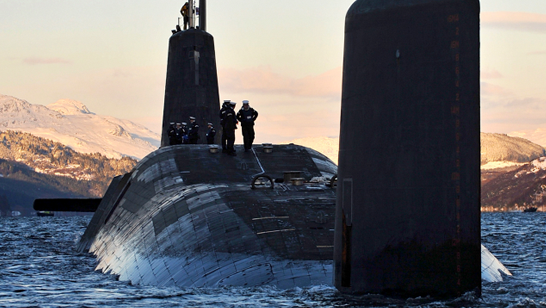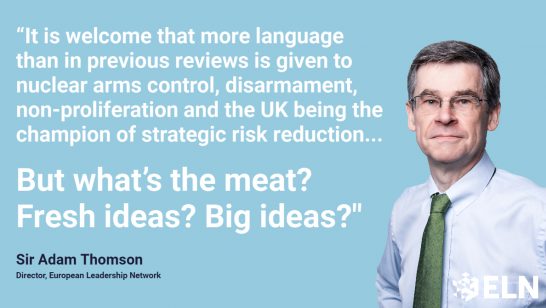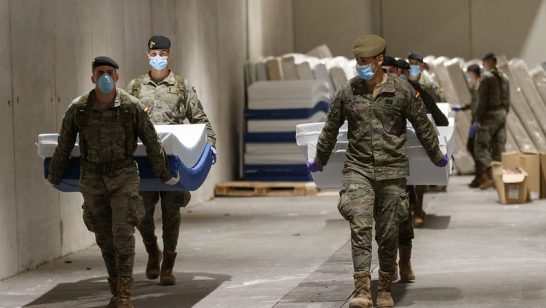
The newly published Integrated Review of Security, Defence, Development and Foreign Policy outlines a world that is shaped by growing multipolarity, a decline of Western liberal values, rapid technological change, growing systemic competition, and the risks associated with the proliferation of novel military technologies.
While the language on China is drafted rather carefully, referring to the country’s “assertiveness”, the review is much more outspoken on Russia which it describes as the “most acute direct threat to the UK”. Yet many emerging and pre-existing threats that the review points out, including the spread of (digital) authoritarianism, military use of space, cyberattacks, and disinformation can easily be linked to both Beijing and Moscow. The document carefully lays out a number of areas where Global Britain has an active influence and – with NATO Allies or with other partners of its choice – can shape global policy for the better. This includes cyber diplomacy, science and technology, and climate change.
Nonetheless, the overall picture painted by the Integrated Review is dismal. It points to the complexity presented by increasing systemic competition between great powers, threats posed by non-state actors, and the pressure issuing from states like North Korea and Iran.
Against this backdrop, the UK proposes to take a decisive step by increasing its nuclear arsenal and toughening its declaratory policy. On the latter, the Review states that the UK will not use or threaten to use nuclear weapons against any non-nuclear weapons state that belongs to, or complies with, the NPT – but, in an important shift, it also says the UK may review this assurance “if the future threat of weapons of mass destruction, such as chemical and biological capabilities, or emerging technologies that could have a comparable impact, makes it necessary.”
This is a marked change. For the past 30 years, the British nuclear weapons stockpile has undergone a progressive reduction from over 500 nuclear warheads during the Cold War to a policy of no more than 225 warheads, established in the 2010 Strategic Defence and Security Review. The same document laid out the aim of going down further to a stockpile of no more than 180 by the mid-2020, a goal that was re-affirmed by the 2015 National Security Strategy and Strategic Defence and Security Review. This reduction was seen as the UK’s contribution to the disarmament obligations enshrined in article VI of the Non-Proliferation Treaty.
Likewise, the UK’s contribution to step-by-step disarmament through a reduction of the number of warheads on each deployed ballistic missile submarine (from 48 to 40), a limitation of the number of operationally available warheads (to no more than 120), and the perspective of reducing the overall stockpile (to 180) were all highlighted by the UK representative at the last review conference of the NPT in 2015.
The Integrated Review now, for the first time since the Cold War, increases the cap of the overall nuclear weapons stockpile, from 225 to 260. Julia Berghofer
The Integrated Review now, for the first time since the Cold War, increases the cap of the overall nuclear weapons stockpile, from 225 to 260. While the text does not explain the logic behind this step, it points to the “evolving security environment” as well as technological and doctrinal threats in a non-specific manner. Obviously, though not explicitly mentioned, the Kremlin’s aggressive rhetoric and an alleged Russian ‘escalate to de-escalate’ strategy have inspired the re-assessment over whether the actual stockpile still serves its purpose of providing a minimum, assured, and credible deterrent.
Now, what implication could this new UK approach have on the upcoming NPT review conference, tentatively scheduled for August 2021? The timing of the increase is far from ideal as the NPT process is already under significant stress. The previous review conference, in 2015, ended without a consensual outcome document. While this is not uncommon for NPT conferences, two ‘unsuccessful’ conferences in a row would be something many in the nuclear community regard as highly damaging for the further survival of a treaty that already suffers from a split membership. With the entry-into-force of the Treaty on the Prohibition of Nuclear Weapons (TPNW) in 2020, the rift between nuclear-weapons states (NWS) in the NPT and their allies, and a significant number of countries that regard the “old” regime as insufficient to foster disarmament on the other, is expected to grow even further. In such a strained climate, a build-up in the arsenals of one of the NWS is not trivial, even if the UK’s nuclear stockpile remains the smallest among the five of them.
One need not be a supporter of the TPNW camp to question the rationale behind the UK’s decision and to what extent it was motivated by political rather than strategic calculations. It is unclear in what sense it contributes to strategic stability – a term the review uses for the first time without explicitly defining it or explaining how the increase in warheads and in nuclear ambiguity contributes to it. In the context of Brexit and the need for putting flesh on the bones of Global Britain, the increase in stockpile could be seen as a politically driven decision to display strength and decisiveness. But this comes at the expense of credibility in the NPT framework. Importantly, one could ask how worthwhile it is to take disarmament steps if they can be reversed? Retrospectively, the value of the UK’s step-by-step process of reducing its arsenal could be seen as void – and it’s difficult to find an argument that makes the recent development consistent with commitments to article VI made by British officials at NPT conferences.
It is even more problematic that the UK will not be confronted with this justified criticism on an individual basis. Rather, one can expect that the non-nuclear weapons states (NNWS) and the TPNW supporters will collectively call out the hypocrisy of NWS and their allies when they seek to bridge the gap through various initiatives like CEND, IPNDV, and NPDI. States like Germany, and other NATO states, have invested a lot of resources into these initiatives in order to identify common ground between the two camps. Their success is now put at risk. Equally, not everyone in NATO will appreciate the growing UK nuclear arsenal, especially as it could be interpreted by Russia as an escalatory step.
In any case, the UK will have difficulties clarifying to their NATO Allies, and within the NPT community, the rationale behind their build-up in terms of British and European security. It will be even harder to justify before the NPT community that this is still in line with Article VI commitments. And, in this context, what then is the ongoing worth of the treaty? For all those who want to replace the NPT and think that it is no longer the right forum for addressing disarmament, the UK’s recent announcement is a welcome opportunity to further fuel tensions.
The opinions articulated above represent the views of the author(s) and do not necessarily reflect the position of the European Leadership Network or any of its members. The ELN’s aim is to encourage debates that will help develop Europe’s capacity to address the pressing foreign, defence, and security policy challenges of our time.
Flickr, Number 10



